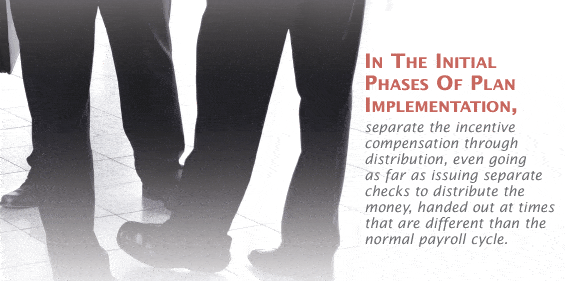Building a Plan
Once your compensation strategy is developed and ready, your leadership team can begin building the compensation plan. The first step to consider is that the plan must meet the needs of the three most important stakeholders:
- The Company – measured through profitable attainment of predetermined goals.
- The Customer – measured through specific customer satisfaction data and increased sales.
- The Employees – measured through who gets rewarded, how much they get rewarded, and for what they get rewarded.

The two key elements in any compensation plan consist of satisfiers and motivators. Each part of the compensation plan will fall into one of these two categories.
Satisfiers are things like base pay and healthcare benefits which allow the attraction and retention of personnel, but don’t provide motivational benefits.
Motivators include things like spiffs, performance pay, incentives, and empowerment activities – items that motivate people to change behaviors to meet the desired outcome.
Employee involvement in plan design is an important aspect of achieving success. This doesn’t mean that the employees decide how much they get paid, but does address the fact that every organization is made up of different people with different needs. What may motivate one individual doesn’t work for another. If the goal is to develop a plan to modify the employees’ behavior through incentives, it is important to discover what best motivates the change.
Every company will benefit greatly from the establishment of a compensation committee. This committee is charged with the responsibility for researching compensation data (like industry standards, and market pay) and reviewing performance evaluation processes. It can also recommend compensation policies to management. This will create a greater sense of fairness and objectivity among the general staff and help to promote buy-in of the plan itself.
The difference between results and effort is an important distinction. Successful compensation plans pay for results. But it’s important to recognize effort because regardless of how hard employees may work, there are times when they don’t achieve results. It should be very clear that the company’s philosophy is to pay for results, and that there is a clear connection between superior performance and superior pay. Look for other ways to reward effort through recognition, especially in situations when factors beyond the employee’s control impact the attainment of the goals.
The level of trust within an organization is the single most important factor in the implementation of any plan. Even a well-designed plan will be rejected by employees if they do not trust the intentions or activities of management. If trust levels are low, use these two key actions to drive them up prior to the implementation of any new compensation plan:
Top-down communication – clear, strong, consistent, and frequent. Research shows that when communication from the CEO is frequent, accurate and strong, trust goes up. Every time a change is implemented, the CEO should communicate around three key points:
- How it will affect the customer.
- How it will affect the company.
- How it will affect the individual.
Under-commit and over-deliver – When the organization sets expectations that cannot be achieved, trust goes down. Work to make sure that the CEO and senior management focus on openly communicating goals that are SMART – specific, measurable, action-oriented, realistic and time-based. Thinking out loud and “bouncing things off” of employees is rarely a good idea as it is often mistaken as a promise from management.

Plan to use meaningful, accurate, relevant and timely measurements to determine whether or not the specific actions and behaviors are achieving the desired effects. Tracking the performance of the individuals, as well as the company, and making those measurements visible, will engage the full force of the company to collectively pursue the primary goals of the organization.
Implementing a Plan
While most of the effectiveness of a compensation plan is contained in the plan design, smooth implementation depends on a few best practices.
Constant Communication – during the design phase, the engagement of employees in a compensation committee goes a long way towards establishing credibility and buy-in from the staff. Regardless of whether a company decides to include a committee, there are two pieces to the puzzle – employee awareness (or education) and the marketing/sales of the plan itself. It’s one thing for employees to know how the plan works, and another to know what’s in it for them. With both areas communicated by management on a regular basis, individual employees clearly understand what’s important to the company and how what they do on a daily basis impacts the goals and their compensation. This ground level communication is critical to the plan’s success, ultimately answering some key questions for the employees:
- What are the goals.
- What’s expected of each employee.
- How they will receive performance feedback.
- What’s in it for them if they follow the plan.
Create Alignment – While it is important to communicate the overarching strategy and compensation plan elements, it’s equally important to focus the measurements and regular communications on only the relevant points for each employee. Take the time to create a meaningful report template for each role and group within the organization that maps their specific targets to their measured efforts. Keep these reports simple, to the point, accurate and timely. The most effective plans reduce the timeframe between effort and reward. Even if you decide not to dish out incentive pay on a weekly or monthly basis, the measurements and communication around progress towards a goal, needs to happen as often as possible. At a minimum, ground-level goals should be measured and posted weekly. When feasible, daily measurements are not too frequent, and in some organizations, hourly updates of sales figures, customers served, and “top-dog” reports are posted to an electronic bulletin board.
Bridge the Gap – Instead of massive compensation changes, think about gradually working into a full model. For example, if your goal is to have incentive compensation make up 30% of the total pay for each person in the organization, work into that figure over a span of a year or two.
Include Owners/Managers – It is important that the incentive compensation plan includes elements for the leadership of the organization. For the employees to adopt the plan and integrate it into the culture, the leadership and staff must engage in a “shared fate” mindset.
Identify and Enlist Champions – Every plan needs champions. You may have heard of the 80/20 principle, but there’s also the 20/20/60 rule – 20% of the people will be behind you no matter what, 20% of the people will be against you no matter what, and 60% will wait and see. Find those people who are going to get behind the plan and leverage their energy and attitude to help the rest of the staff see the future benefits of the change.
Separate Base Pay from Incentives – In the initial phases of plan implementation, separate the incentive compensation through distribution, even going as far as issuing separate checks to distribute the money, handed out at times that are different than the normal payroll cycle. Keeping the incentives separate, prevents the “entitlement” attitude, and reminds employees that the incentives are “at risk” pay.

Strategic Compensation
Designing, planning, and implementing a performance-based pay system is a strategic undertaking. It consumes time and energy, and because it affects how much your employees are paid, it can be emotionally taxing as well. Done poorly, it can drive good people from the business. Done well, it will attract and retain the best of the best. Management should consider whether or not, and at what point, enlisting the services of an outside consultant to assist in the process is necessary.
If your organization is considering the implementation of a performance-based pay system, and would like more information and materials to assist in the process, contact the author at rbaker@furninfo.com for a CDROM with materials such as checklists, examples and ideas.
Ren Baker is the president and CEO of CDS Solutions Group, a business and software solutions company. Dedicated to bringing emerging technologies to the home furnishings industry. Baker assists companies in implementing business best practices and automating through software and operating systems. He also writes for a number of industry publications and conducts workshops on business/retailer issues and technology. Questions can be sent to Baker at rbaker@furninfo.com.